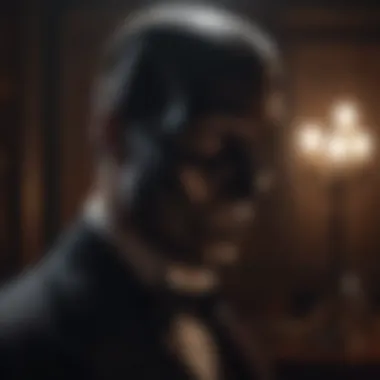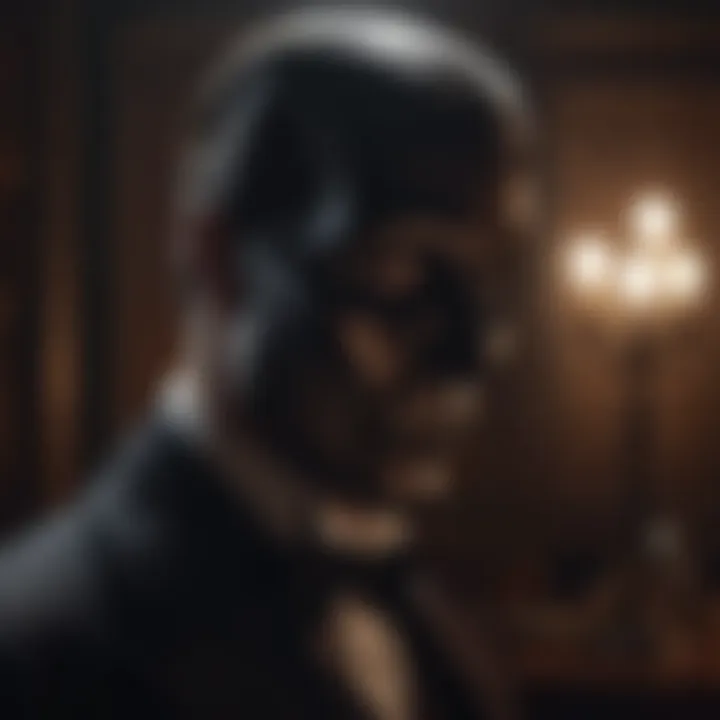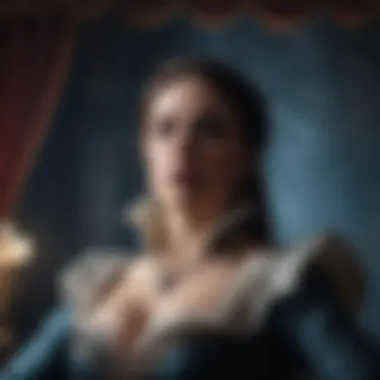Exploring 'Music of the Night' in The Phantom of the Opera


Intro
The song "Music of the Night" stands as one of the most memorable elements of Andrew Lloyd Webber’s The Phantom of the Opera. Within the haunting atmosphere of this musical, the piece plays a pivotal role in deepening the narrative's emotional layers. It encapsulates the complex feelings of the characters and creates an immersive experience for the audience. By peeling back the layers around this song, one can appreciate the artistry and thought that went into its composition.
Artist Profile
Biography and Background
Andrew Lloyd Webber, the mastermind behind The Phantom of the Opera, was born on March 22, 1948, in London, England. He has been a leading figure in musical theatre, creating numerous acclaimed works. His father was a composer and his mother a piano teacher, which fostered a strong musical environment. Webber's early exposure to classical music and theatre shaped his distinctive style.
His collaborations, such as with lyricist Tim Rice, led to successful pieces like Joseph and the Amazing Technicolor Dreamcoat and Evita. In 1986, Webber composed The Phantom of the Opera, which became one of the highest-grossing musicals worldwide.
Major Influences and Inspirations
Webber’s influences are diverse, including classical composers like Verdi and Wagner. Other significant inspirations stem from his adventures in the rich culture of musical theatre, drawing from operatic traditions while incorporating modern music styles. His ability to blend genres is evident in Music of the Night, marrying lush romantic melodies with intense lyrics that reflect the story’s themes of desire and longing.
"Music is a doorway to the soul; it captures feelings words cannot express."
Song Analysis
Theme and Lyrics Breakdown
Music of the Night serves as a dramatic declaration of the Phantom's allure and his desire for Christine. The lyrics express themes of seduction, darkness, and sensitivity. The phrase "Let your soul take you where you long to be" invites listeners to explore their deepest emotions. Each line contributes to the overall haunting effect, revealing the Phantom's complex character. His intentions are both passionate and unsettling, creating tension that drives the narrative.
Instrumentation and Composition
The composition of Music of the Night showcases Webber’s prowess in orchestrating music that enhances storytelling. Notable elements include:
- Rich Orchestration: Strings play a dominant role, providing an ethereal quality that complements the vocals.
- Melodic Structure: The melody rises and falls, mirroring the emotional landscapes of desire and despair.
- Harmonic Progression: The song utilizes minor keys, evoking a sense of mystery and intrigue that aligns with the Phantom's character.
The combination of these musical choices contributes to the song's lasting impact on audiences and its place in the pantheon of musical theatre. By examining the details, we can see how Music of the Night is not just a song but a narrative device that enriches the entire production.
In summary, this exploration of Music of the Night reveals the artistic decisions that make it an essential element of The Phantom of the Opera. As we continue to analyze its reception and legacy, the depth of Webber's creation remains a significant point of discussion for music enthusiasts and theatre scholars alike.
Overview of The Phantom of the Opera
The significance of The Phantom of the Opera in the realm of musical theatre cannot be understated. This iconic production has set a high standard for narrative depth and musical composition. It is a story of love, obsession, and tragedy, effectively drawing in audiences around the world for decades. The central character, Erik, also known as the Phantom, serves as a powerful embodiment of inner conflict and emotions. His intricate relationship with Christine Daaé and Raoul highlights the complex interplay of desire and moral choice.
The setting of the Paris Opera House adds to the mystique and allure of the story, making it a fascinating backdrop that enhances the musical themes. The Phantom of the Opera engages with themes such as love, isolation, and the quest for acceptance, enriching its narrative texture.
Historical Context
The historical context of The Phantom of the Opera reveals its roots in literature and the societal changes of its time. Written by Gaston Leroux in the early 20th century, the original novel has influenced numerous adaptations. The transition from text to stage by Andrew Lloyd Webber in 1986 marked a pivotal moment in musical theatre history. This adaptation incorporated grand musical scores and an innovative use of technology, effectively transforming the narrative into a visual and auditory spectacle. This historical backdrop is essential to understand the evolution of themes, character development and the song 'Music of the Night.'
Character Analysis
Character analysis provides a nuanced understanding of the driving forces in The Phantom of the Opera. Each character embodies distinct qualities that contribute to the unfolding drama, enriching the audience’s experience.
Erik's Complexity
Erik, the Phantom, is a figure of intricate layers. His complexity lies in the duality of his nature—both creator and destroyer. He represents the tortured artist, driven by his passion yet consumed by isolation. This depth is compelling for this article, as it resonates strongly with the themes of longing and despair in 'Music of the Night.' The unique feature of Erik's character is his juxtaposition of beauty and horror. He is both a musical genius and a tragic figure. This complexity allows audiences to empathize with him, despite his ominous actions.
Christine's Journey


Christine Daaé's journey is characterized by transformation and self-discovery. From an innocent young woman to a figure of profound emotional strength, her character grows through her experiences with Erik and Raoul. This evolution is integral to understanding the emotive core of 'Music of the Night.' The essence of Christine’s journey is her struggle between her feelings of fear and her desire for love. It reflects the broader themes of choice and consequence. Her unique role in engaging with Erik offers insights into themes of vulnerability and empowerment.
Raoul's Role
Raoul serves as a contrast to Erik’s character. His role as the noble suitor positions him as a figure of light in a narrative heavy with darker themes. Raoul’s unwavering love for Christine represents hope and the potential for redemption. This dichotomy makes his character a beneficial focus for this article. The distinctiveness of Raoul’s persona is his representative role of normalcy and societal values against Erik's chaotic influence. Nonetheless, Raoul's more straightforward character can sometimes lack the emotional depth that Erik or Christine embodies. This offers a balanced view of the tumultuous relationships within the narrative.
Understanding these characters along with their intricacies contributes significantly to the exploration of 'Music of the Night.' It sets the foundation for analyzing how this song encapsulates their journey while intertwining their emotional conflicts throughout the larger narrative.
Understanding 'Music of the Night'
The song 'Music of the Night' holds a vital place in The Phantom of the Opera, functioning not just as an individual piece but also supporting the overall narrative and character arcs. Its intricate melody, layered harmonies, and profound themes contribute significantly to the understanding of both Erik's and Christine's journeys. The detailed exploration of this song provides insight into the emotional depth and artistic choices made by Andrew Lloyd Webber. By dissecting the composition, structure, and thematic elements of the piece, we uncover the essence of what makes 'Music of the Night' compelling.
Composition and Structure
Melodic Elements
The melodic line of 'Music of the Night' stands out for its sweeping and flowing quality, which enhances the emotional gravity of the song. One key characteristic of these melodic elements is how they articulate different emotional nuances. This fluidity reflects Erik’s seductive yet dark nature. The use of sustained notes creates a sense of longing and desire, inviting listeners to engage with the character’s inner turmoil. The choice of such a melody draws the audience deeper into the emotional landscape of the characters, making it a powerful element in the song's overall impact.
The unique feature is the contrasting ranges, which bring both tension and release, resonating with the audience’s emotions. This creates a balance between haunting beauty and an unsettling atmosphere, contributing to the duality of Erik's nature as both an object of desire and a figure of fear.
Harmonic Components
The harmonic structure of 'Music of the Night' underpins its melodic journey remarkably. The chord progressions often lean toward minor keys, conveying a sense of melancholy. This characteristic supports the narrative’s themes of unfulfilled longing and desperation. The harmonic choices are beneficial for enhancing the emotional weight of the song. They amplify the haunting qualities of the melody, allowing the lyrics to penetrate more deeply into the listener's psyche.
One unique aspect of the harmonics is its use of chromaticism, creating tension that elevates the dramatic effect. This can be seen as advantageous in allowing the audience to feel the complexity of emotion without resorting to overt theatrics.
Rhythmic Patterns
The rhythmic patterns in 'Music of the Night' play a crucial role in shaping its overall feel. The song employs a gentle and flowing rhythm that mirrors the seductive nature of the content. This characteristic is essential, as it invites a hypnotic quality that immerses the audience in the experience. The decision to use such rhythmic structures is beneficial as it aligns with the themes of obsession and allure present in the narrative.
The unique feature here is the alternation between legato sections and brief pauses, which creates a push-and-pull dynamic that draws listeners in and keeps their attention. While these qualifications can be seen as limitations in more fast-paced pieces, they serve to deepen the intimacy of 'Music of the Night'.
Thematic Exploration
Themes of Desire
The theme of desire is palpably present in 'Music of the Night'. It reflects Erik’s longing for connection, though it is often shrouded in danger and obsession. This theme captures the essence of the story and develops Erik's character as a figure striving for love and acceptance. This choice resonates with the audience, making the song a poignant expression of yearning.
A unique aspect is how the desire is not simply romantic but also entwined with power dynamics, showcasing different facets of relationships. This layered representation is particularly advantageous, as it lends depth to both Erik and Christine’s interactions.
Themes of Isolation
Isolation is another powerful theme in 'Music of the Night'. It encapsulates Erik's emotional state, portraying his alienation from society. This aspect is crucial for understanding his character, as it adds complexity to his motivations. The reflective nature of this theme makes it a compelling choice for exploration in this article.
The unique feature of this theme is its duality – while Erik is isolated, the song also highlights Christine's own struggles with her identity and the expectations surrounding her. This interplay can be both enlightening and moving.
Symbolism in the Lyrics
The lyrics of 'Music of the Night' are rich with symbolism. Phrases often evoke imagery of darkness and light, connecting to broader themes within the narrative. A key characteristic is the way these words vividly paint Erik's world, allowing the audience to grasp his perspective.
This use of symbolism is a beneficial choice, enhancing the layers of meaning in the song. One unique feature is how it engages with the audience's imagination, enabling them to interpret the deeper significance of the lyrics as they relate to desire, fear, and beauty. This added depth enriches the article by showing how the language motivates emotional resonance.
Lyrics Analysis
The lyrics of "Music of the Night" play a vital role in conveying the emotional depth and complexity of the narrative in The Phantom of the Opera. Understanding the lyrics enhances our appreciation of the characters and themes embedded within the musical. This section will dissect elements such as language, imagery, and narrative function to highlight how the words contribute to the overall impact of the song and the musical as a whole.


Language and Imagery
The language used in "Music of the Night" is both poetic and evocative. Through carefully chosen words, Andrew Lloyd Webber establishes a rich tapestry of sensory experiences. The imagery invites listeners into a realm of darkness and desire, encapsulating Erik's emotional state and his longing for connection.
Phrases such as "night" and "dream" create a sense of mystery and allure, while the juxtaposition of light and dark throughout the lyrics establishes Erik's internal conflict. This language serves not only to embellish the musical score but also to convey the depth of Erik's character. The lyrical content paints a vivid picture of his world, which is filled with isolation juxtaposed against an intense desire for love.
Narrative Function
The narrative function of "Music of the Night" is twofold. On one hand, it advances the plot, while on the other, it reveals significant character insights. These dual aspects contribute to the song’s importance in the overall narrative structure of The Phantom of the Opera.
Advancing the Plot
"Music of the Night" actively propels the story forward by presenting Erik's intentions and his fascination with Christine. The setting of this moment allows the audience to experience Erik's charm and his manipulative nature simultaneously. This song effectively moves the plot towards critical turning points, such as Christine's eventual choices and her understanding of Erik.
The key characteristic of advancing the plot through this song lies in its ability to encapsulate the urgency of Erik's desires. The lyrics serve as a means to compel Christine, making them a beneficial choice for the narrative. However, the unique feature of plot advancement in this song lies in how it also deepens audience engagement with Erik's character. This duality can introduce complexities, as listeners might wrestle with sympathizing with a character who embodies both beauty and terror.
Character Revelations
In addition to advancing the plot, "Music of the Night" reveals essential aspects of character development, particularly Erik's personality and emotional turmoil. The lyrics unveil his vulnerabilities and desires in a manner that enhances our understanding of him as a tragic figure. The contrast between Erik's dark world and his desire for love is brought to life through the lyrics, drawing listeners into the inner workings of his character.
The key characteristic of character revelations here is that they allow for a nuanced view of Erik. Instead of viewing him solely as the antagonist, the audience gets a glimpse into his longing for acceptance. This is a popular choice for musical narratives, as it invites empathy towards traditionally villainous characters. However, a unique feature of this revelation is how it can complicate the audience's perception of right and wrong within the story. This complexity may challenge interpretations of Erik's actions and motives, enriching the narrative and encouraging deeper discussions about morality in the context of his character.
The Role of 'Music of the Night' in Character Development
The song 'Music of the Night' is a pivotal element in The Phantom of the Opera, forming a bridge between the characters' emotional journeys and their development throughout the narrative. This section examines how this haunting composition illuminates the inner turmoil of Erik, the Phantom, and marks the transformation of Christine. The song is not just a melody; it is a reflection of their desires, fears, and the profound connections that bind them.
Erik's Perspective
From Erik's viewpoint, 'Music of the Night' serves as an expression of his deepest longing. He is a character shrouded in isolation and despair, haunted by his physical deformity and social rejection. The lyrics convey his yearning for companionship and acceptance. As he sings, he invites Christine into his world, one that juxtaposes beauty and darkness. This invitation is layered with seduction, promising her an escape from the mundane.
Through the song, Erik reveals his vulnerability. His haunting voice reflects not only his desires but also his tragic fate. He seeks to enchant Christine, to draw her into his existence, albeit a life marked by shadows. The music mirrors his internal conflict; it is both alluring and sinister. This complexity adds depth to Erik's character, illustrating him as both a creature of beauty and a figure of dread, showcasing the duality of his nature.
"The music serves as Erik's plea, showing his need for connection despite the world around him that has turned its back."
Christine's Transformation
In contrast, for Christine, 'Music of the Night' is transformative. Initially, she is depicted as an innocent young woman, caught between two worlds: the ordinary and the extraordinary. Erik's song introduces her to a realm of hidden emotions and desires that she has not fully acknowledged until now. As she listens, Christine begins to explore her own identity and aspirations.
The song acts as a catalyst for her growth. It compels Christine to confront her feelings towards Erik and Raoul, the other significant figure in her life. Where Erik represents passion and mystery, Raoul embodies safety and familiarity. This internal struggle is at the heart of her character development, reflecting the broader theme of choosing one’s own destiny.
Through the haunting melody and Erik's seductive lyrics, Christine grasps the complexities of love and sacrifice. By the end of the song, she is not just a passive participant; she becomes an active player in her own story. This marks the beginning of her journey towards self-awareness and empowerment, ultimately shaping her decisions later in the narrative.
Cultural Impact of 'Music of the Night'
The cultural impact of 'Music of the Night' extends far beyond its role in The Phantom of the Opera. This song encapsulates a vibrancy that speaks to audiences from different backgrounds and ages. Its profound themes and haunting melodies have allowed it to resonate deeply in the sphere of musical theatre and beyond. This section explores some specific elements that highlight its monumental cultural influence.
Influence on Musical Theatre
The significance of 'Music of the Night' can be seen in how it has shaped the landscape of musical theatre. For many, it represents a pivotal moment where a musical number conveys not just emotion, but depth of character and narrative progression. The song demonstrates how musical elements can be utilized to elevate storytelling. Andrew Lloyd Webber's ability to blend lyrical poignancy with intricate composition has set a standard in musical writing.
Furthermore, the lush orchestration and multilayered harmonies exemplify how music can contribute to theatre. Many productions have adopted its methodology for incorporating solos that not only entertain but also provide insight into characters’ psyches. This influence reaches new productions, inspiring songwriters and composers to explore similar themes of longing and desire.
Reception and Popularity
Critical Acclaim


The critical acclaim surrounding 'Music of the Night' is a testament to its exceptional composition. Critics highlight its emotional resonance and how it captures the essence of Erik's character. Reviewers have consistently praised the song’s ability to create a profound connection between the character and the audience. This acclaim contributes to its lasting relevance.
Unique to its praise is the way in which the song’s structure invites interpretation. Many scholars argue that the melodic rises and falls symbolize both hope and despair, reflecting Erik’s internal conflict. This unique quality makes it a fascinating subject for analysis, benefiting readers interested in complex musical narratives.
Audience Reception
The audience reception of 'Music of the Night' demonstrates its widespread appeal. Many listeners describe the song as haunting and beautiful, evoking strong emotional responses. This reception is crucial in understanding its cultural footprint. Its inclusion in various performances and media reinforces its lasting power.
A defining feature of audience reception is how it brings people together. Fans often share their favorite versions and covers on platforms such as Reddit and Facebook, creating a dialogue around the song. This interaction enriches the community experience, providing multiple avenues for discussion and appreciation among music enthusiasts.
"'Music of the Night' captivates audiences, not just as a song but as an elaborate weaving of emotions and narrative."
Variations and Interpretations
Variations and interpretations of 'Music of the Night' are crucial in understanding the song's multifaceted presence in cultural contexts. Variations provide a lens into how different artists perceive and reinterpret the same musical material. This aspect allows listeners to explore the core emotions of the song while also appreciating the unique artistry of each performer.
Stage Adaptations
In various stage adaptations, 'Music of the Night' has been reimagined countless times to suit different narratives. Each performance might highlight distinct elements, such as vocal delivery or orchestration. Notably, interpretations often reflect the character dynamics and ambient mood of particular productions. The 25th Anniversary Concert at the Royal Albert Hall is an excellent example. Here, the orchestration was lush, emphasizing the theatricality of the Phantom's character.
Adaptations can also reflect regional interpretations. For instance, performances in Asian markets often incorporate local musical styles, infusing the original score with flavors that deviate from Western standards. Such modifications deepen the emotional resonance of the lyrics, providing audiences with fresh auditory experiences.
- Key Considerations of stage adaptations include:
- Vocal style and inflection specific to the performer.
- Instrumentation choices that reflect cultural contexts.
- Stage direction and choreography influencing how the song is perceived.
Recordings and Covers
The vast number of recordings and covers of 'Music of the Night' illustrates its impact on various genres. From classical interpretations to pop renditions, each version opens a window into new artistic expressions. Collaborations with renowned artists, such as Michael Crawford or Sarah Brightman, bring diverse stylistic choices, enriching the song's legacy.
While classical covers maintain original arrangements, modern renditions often introduce contemporary elements, making the song accessible to a broader audience. For example, contemporary artists might layer electronic music with the traditional score, creating a fusion that resonates with younger listeners.
- Benefits of diverse recordings include:
- Exposing the song to new demographics and communities.
- Offering music enthusiasts a broad spectrum of auditory experiences.
- Elaborating on the song's themes through varied lyrical interpretations.
“The beauty of music lies in its adaptability – ‘Music of the Night’ showcases this phenomenon through its myriad versions.”
In summary, the exploration of variations and interpretations of 'Music of the Night' reveals not only the song's enduring power but also how it continues to evolve. These adaptations highlight the song’s capacity to transcend cultural and temporal boundaries, making it relevant and cherished across generations.
Culmination and Reflection
The significance of examining the intricacies of 'Music of the Night' in the context of The Phantom of the Opera is being clearly defined by the layers it adds to both the musical and the narrative. Recognizing the diverse elements at play in the song allows for a multi-dimensional understanding of its role. The discussion emphasizes how this piece reflects the complex emotional landscape of its characters, particularly Erik, Christine, and the broader themes of desire and isolation.
Legacy of 'Music of the Night'
'Music of the Night' holds a distinguished place in the annals of musical theatre. This piece has transcended its original medium, becoming a touchstone in various cultures. Here are the important factors contributing to its legacy:
- Cultural Relevance: The song’s themes resonate across diverse audiences, reflecting universal emotions such as longing and desperation.
- Influential Variations: Artists and singers have interpreted the song in various styles, allowing it to evolve while staying true to its essence.
- Awards and Recognition: It has garnered numerous accolades, maintaining its status as one of the most celebrated songs in musical history.
'Music of the Night' plays an essential role in showcasing the capabilities of musical theatre to convey deep emotional narratives. The song's haunting melody and rich lyrics encapsulate the turbulence of the characters, thus ensuring its lasting impact.
Final Thoughts on Its Significance
In summary, 'Music of the Night' serves not just as a musical number but as a profound narrative device. Its significance lies in its ability to summarize and embody the emotional core of The Phantom of the Opera. This piece provides critical insights into:
- Character Development: It reveals aspects of Erik’s complex psyche and Christine’s transformation, highlighting the interplay of love, obsession, and fear.
- Thematic Exploration: The song encapsulates the overarching themes of desire and isolation, providing a rich context for the unfolding drama.
- Artistic Achievement: Musically, it exemplifies Andrew Lloyd Webber's genius in creating memorable melodies that resonate with audiences, both emotionally and intellectually.
"'Music of the Night' is not merely a song but a representation of a world filled with longing, a reflection of the darker sides of human emotion."
Appreciating the intricate details and the legacy of this song fosters a deeper understanding of its role within the larger narrative of The Phantom of the Opera. For music enthusiasts, aspiring musicians, and music students, it becomes a study of how artistry can evoke profound emotional responses and create lasting connections through a singular piece.







